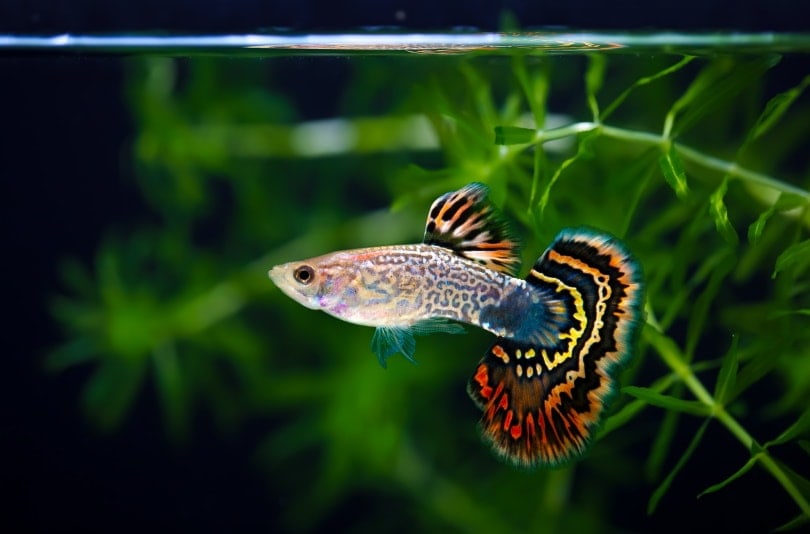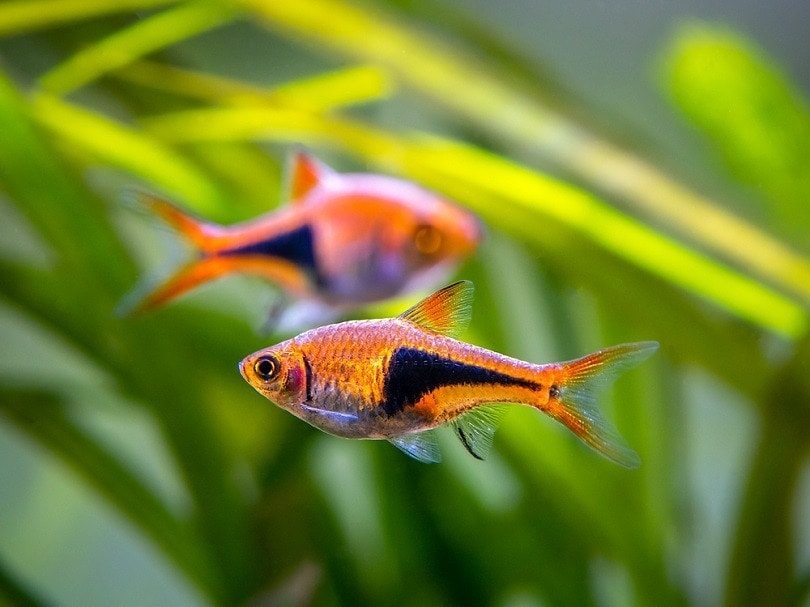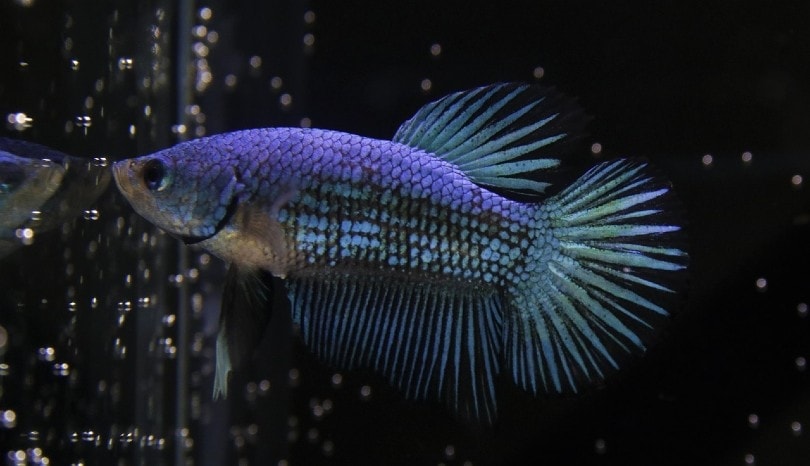15 Best Fish for a 20-Gallon Tank: Type & Quantity Explained (Vet-Reviewed Info)
Updated on

One of the most exciting parts of setting up a new tank is choosing which fish to keep inside. Fish tanks are available in a range of different sizes, but 20 gallons is a common favorite. A 20-gallon tank gives you more room than the smaller sizes without being too large for most homes and offices. These tanks are relatively easy to maintain and fit most standard aquarium equipment and decorations inside.
However, that doesn’t mean that this tank size is suitable for every fish. You need to carefully consider the size, behavior, and waste bioload when choosing fish for your 20-gallon tank. Fortunately, many types of fish can be comfortably housed in these tanks.

How Are Fish for a 20-Gallon Tank Classified?
Fish that are suitable for 20-gallon tanks are classified by their small size and small group numbers. They can either be marine, brackish, or freshwater fish and live at varying temperatures.
You generally want to avoid larger fish that grow over 4 inches long, therefore requiring more tank space. Large schooling fish that should be kept in groups should also be avoided as a 20-gallon will not offer them enough swimming space. You should consider the fish’s behavior too, so choose ones that are not highly active or easily stressed in small environments. It is best to stick to fish that require 20 gallons or less as a minimum tank size.
The 15 Best Fish for a 20-Gallon Tank
Let’s take a look below at the best fish you can keep in a 20-gallon tank.
1. Neon Tetras

| Origin: | South America |
| Lifespan: | 3 to 5 years |
| Length: | 1.5 inch |
Neon Tetras (Paracheirodon innesi) are small schooling fish hailing from tropical South American waters. You can find these small fish inhabiting freshwater streams and river basins littered with leaves and fallen roots. Neon Tetras have distinctive red and blue bodies which reflect under bright aquarium lighting. Despite their small size, Neon Tetras can liven up a 20-gallon tank and add a dash of color. Caring for Neon Tetras in a 20-gallon is relatively simple, making them ideal for beginners.
As tropical fish, Neon Tetras require a heater and a filter. They thrive at temperatures between 72° to 80° Fahrenheit, but the temperature needs to be kept stable. Neon Tetras benefit from live plants, sandy substrates, and driftwood in tanks. You will need to keep these vibrant fish in groups of six or more to form schools.
2. Pygmy Cory

| Origin: | South America |
| Lifespan: | Up to 5 years |
| Length: | 1 inch |
The Pygmy Cory (Corydoras pygmaeus) is one of the smallest aquarium catfish species. The adults grow to about 1 inch long, but some might be smaller. Pygmy Cories can be found throughout Brazil and Peru, specifically in the Madeira River basin. They are a schooling species that needs to be kept in groups of five or more. They inhabit the bottom of an aquarium where they explore and socialize with members of their group.
You can recognize the Pygmy Cory by their shiny silverish beige coloration and distinctive black lines. Pygmy Cories will have plenty of room in a 20-gallon tank, provided that it is filtered and heated. They are omnivores, but readily eat leftover food from other tank mates.
3. Zebra Danios

| Origin: | South Asia |
| Lifespan: | 2 to 5 years |
| Length: | 1.5 inch |
Zebra Danios (Danio rerio) are kept as pets, used for research purposes, and in the wild. They are tropical freshwater fish found in Bangladesh and India. These tiny fish have striped bodies and range in color from vibrant blue, greens, pinks, and orange. Zebra Danios are incredibly hardy and adaptable fish that thrive in various tank sizes and setups. A 20-gallon tank is perfect for five to eight Zebra Danios, provided it is kept filtered and heated. Zebra Danios can tolerate a range of different temperatures, but 65–76 °F (18–24 °C) is preferred. They are active fish that have fast, dart-like movements as they swim.
4. Rummynose Tetras

| Origin: | South America |
| Lifespan: | 5 to 8 years |
| Length: | 2 inches |
Named after their striking appearance, Rummynose Tetras (Petitella rhodostoma) make fascinating additions to 20-gallon tanks. These small Tetras rarely exceed 2 inches long and stand out with their zebra-striped caudal fins and blood-red faces. Rummynose Tetras are found in lakes, streams, and sandy river beds in South America. They prefer heavily planted aquariums because their natural habitat consists of slow-moving, heavily vegetated waters.
Rummynose Tetras form schools in the wild and aquariums, so be sure to keep them in groups of six or more. When Rummynose Tetras are kept in tropical and heated tanks in large groups, they actively swim around the tank. Having live freshwater plants in their tank encourages these tetras to feel safer.
5. Fancy Guppies

| Origin: | South America |
| Lifespan: | Up to 5 years |
| Length: | Up to 2.5 inches |
Fancy guppies (Poecilia reticulata) are among the most popular freshwater fish in the world. These fish are easy to care for, breed, and maintain in both larger and small aquariums. Fancy guppies make perfect additions to filtered and heated 20-gallon tanks. They are found in endless colors and patterns, including brilliant blues, yellows, and leopard markings. You can mix and match different varieties of Fancy guppies to liven up a 20-gallon tank.
Unlike the fish mentioned above, guppies are not schooling fish. However, they are social and may prefer each other’s company. As livebearers, they should be kept in a ratio of at least 2 females per male – with more females per male being even better.
6. Green Swordtail

| Origin: | Central America |
| Lifespan: | 3 to 5 years |
| Length: | 3 to 5.5 inches |
Green Swordtails (Xiphophorus hellerii) are live-bearing fish belonging to the Poeciliidae family. Despite the name including a color reference to green, they’ve been selectively bred to produce different colors which can be found in the aquarium trade; red is the most common color for swordtails found as pets. However, the only true wild species of this fish is the green variation.
They are named after the male elongated caudal fin which resembles swords. Swordtails are found throughout North and Central America, specifically from Mexico and Veracruz. The female Swordtails are more plain (but larger) compared to the males and closely resemble Platyfish. Swordtails are interesting fish because they do not deposit eggs like you would expect, but rather give live birth to free swimming fry.
Furthermore, Swordtails do not disappoint when it comes to their appearance. These fish boast vivid red, orange, yellow, green, or blue bodies. A group of five to six Swordtails can be housed in a 20-gallon if it is kept heated.
7. Ember Tetras

| Origin: | South America |
| Lifespan: | Up to 10 years |
| Length: | 0.8 to 1 inch |
Ember Tetras (Hyphessobrycon amandae) are striking freshwater fish with distinctive reddish-orange bodies. These Tetras stand out against dark-colored tank backgrounds and substrates, despite their small size. Ember Tetras are found in freshwater habitats with a preferred temperature range of 75–82.4 °F (24–28 °C). These active schooling fish pair well with other small and peaceful fish and rarely show signs of aggression.
Ember Tetras thrive in groups of six or more, but larger groups encourage their natural schooling behavior. Caring for Ember Tetras is relatively simple, and they make undemanding pets for beginner and experienced fish keepers alike.
8. Harlequin Rasboras

| Origin: | Southeast Asia |
| Lifespan: | 5 to 8 years |
| Length: | 0.8 to 2 inches |
Harlequin Rasboras (Trigonostigma heteromorpha) are small fish recognized by the black triangular marking at the base of their caudal fin. They inhabit forest pools, streams, and rivers in Southeast Asia within the Malay peninsula. Harlequin Rasboras are peaceful and active fish that form schools, so they should be kept in groups of six or more.
These fish enjoy planted aquariums with natural tannins in the water, but they can adapt to any pH between 6.0–8.0 (as long as it is consistent). Tannins are found in their natural habitat from decaying plants and other organic materials. Their tank should be heated, filtered, and decorated with live plants and ideally driftwood.
9. Dwarf Gouramis

| Origin: | South Asia |
| Lifespan: | 4 to 6 years |
| Length: | 2 to 4.5 inches |
If you are looking for a peaceful medium-sized fish for your 20-gallon tank, the Dwarf Gourami (Trichogaster lalius) might be a good choice. Dwarf Gouramis are vibrantly colored fish belonging to the Osphronemidae family. They have distinctive string-like ventral fins which they use to navigate and sense their environment.
Dwarf Gouramis are available in many different colors, such as sunset, flame, honey, and powder blue. They are naturally peaceful and social fish that can cohabit well with other peaceful schooling fish. A small group of three to five Dwarf Gourami can be housed in a freshwater 20-gallon tank. Though they’re relatively small and peaceful, they don’t get along with another popular top dweller, the Betta (Betta splendens).
10. Elegant Firefish

| Origin: | Indo-West Pacific |
| Lifespan: | 3+ years |
| Length: | 3 inches |
Most reef setups are at least 40 gallons in size. If you’re considering a smaller aquarium for such a setup, ensure you are well versed with keeping saltwater fish and setting up reefs.
The Elegant Firefish (Nemateleotris decora) is a marine species native to the Indo-West Pacific, from Mauritius to New Caledonia. They are a type of dartfish, which is why they go by other common names like Purple or Decorated Dartfish.
Elegant Firefish are small at a maximum length of 3 inches. Their size makes them suitable for nano reef aquariums, especially 20-gallon tanks. Their captivating appearance consists of vibrant purple fins and an off-white narrow body. A single Elegant Firefish can be housed in a 20-gallon marine tank.
They follow a solitary lifestyle and spend their time foraging for food at the bottom of the tank. Water quality and proper tank maintenance are key to their survival, so they are better suited for seasoned saltwater aquarists.
11. Female Betta Fish

| Origin: | Southeast Asia |
| Lifespan: | 2 to 3 years |
| Length: | 2 to 3 inches |
Although the males of this species often get the spotlight, female Bettas make fascinating pets too. Female Bettas (Betta splendens) can be housed alone (with other community fish of different species) or a small sorority can be housed in a 20-gallon fish tank. Female Betta fish should be kept in tropical freshwater tanks with plenty of live plants and gentle filtration. It is recommended to keep their tank heated between 75–86 °F (24–30 °C) for optimal health. As carnivores, Bettas require a protein-rich diet supplemented with live fish foods.
12. Celestial Pearl Danios

| Origin: | Southeast Asia |
| Lifespan: | 3 to 5 years |
| Length: | 1 inch |
Celestial Pearl Danios (Danio margaritatus) or Galaxy Rasboras are colorful freshwater fish native to Myanmar. They only grow to an inch long but stand out with their striking coloration. Their bodies are a blue coloration with off-white dots and bright reddish-orange fins. They have peaceful and social temperaments and make excellent community fish. Celestial Pearl Danios should be kept in groups of six or more as they are a schooling species. A 20-gallon tank with a heater and live plants can house six to eight of these Danios, but more if they are not kept with tank mates.
13. Ram Cichlids

| Origin: | South America |
| Lifespan: | 2 to 4 years |
| Length: | 2 to 3 inches |
The small and more peaceful members of the Cichlidae family are Ram Cichlids (Mikrogeophagus ramirezi). While Cichlids often have a reputation for being large and aggressive, Ram Cichlids are an exception. Ram Cichlids are a dwarf species that grow to around 2 to 3 inches long. They are native to the Orinoco River basin and its tributaries.
Ram Cichlids go by other names such as Butterfly Cichlids, Asian Rams, or German Blue Rams which describe their colorful appearance. You can house them in spawning pairs or small groups. However, only a spawning pair (and no other fish) is suitable for a 20-gallon-long tank. This is because the spawning pair will turn aggressive towards their tank mates when they decide to lay their eggs. These fish care for their young, and therefore will continue to be aggressive as long as they feel like a nearby fish is a threat to their young.
14. Kuhli Loaches

| Origin: | Southeast Asia |
| Lifespan: | 10 to 14 years |
| Length: | 3 to 4 inches |
If you are looking for an unusual tropical fish for your 20-gallon tank, the Kuhli Loach is worth considering. Kuhli Loaches (Pangio kuhlii) have distinctive pencil-like bodies and eel-like swimming movements. They originate from Southeast Asia in slow-moving rivers and streams. Kuhli Loaches generally have tan and dark brown stripes, but they can be found in other colors and patterns.
These tropical fish prefer to swim along the tank’s bottom and burrow in sand or fine gravel substrates. They are most active at night or when the tank lights are turned off because they are nocturnal. Kuhli Loaches will form loose groups with their species and spend time hiding, eating, and burrowing together. A group of three to seven Kuhli Loaches can be kept in a 20-gallon long tank.
15. Peacock Gudgeon

| Origin: | Papua New Guinea |
| Lifespan: | 4 to 5 years |
| Length: | 3 inches |
Peacock Gudgeons (Tateurndina ocellicauda) are colorful freshwater fish native to rainforest streams in Papua New Guinea. Alternative names for this species include the Peacock Goby, although it is not a true Goby. They have brightly colored bodies with striking blues, reds, yellows, and uneven stripes.
They are not as common in the aquarium trade industry as many other freshwater fish. It is unclear why many fish keepers have never heard of them, despite their ease of care and compatibility in planted nano tanks. A 20-gallon tank with a filter, heater, substrate, and live plants can comfortably house a pair of Peacock Gudgeons. They are naturally social and peaceful fish, but the males can be territorial.

How Many Fish Can You Keep in a 20-Gallon Tank?
The amount of fish you can keep in a 20-gallon tank is usually limited to smaller species under 4 inches long. A 20-gallon tank can house a group of schooling fish such as Neon tetras or Zebra danios. With schooling or shoaling fish, a group size of six to eight is often recommended. For larger fish like the Dwarf Gourami and Ram Cichlid, smaller numbers are preferred. You do not want to overstock your 20-gallon tank, even if it runs a strong filter.
You do not have to stick to a species-only 20-gallon tank. You have the option of combining different species mentioned in this article to create a community aquarium. For example, bottom-dwelling Kuhli loaches can be housed with schooling Neon tetras.
The amount of fish your 20-gallon tank can handle usually depends on the species you plan to keep, your water parameters, the filter’s strength and quality, the aquascape itself, and the maintenance you plan to do.
Featured Image Credit: Alex Unders, Shutterstock











